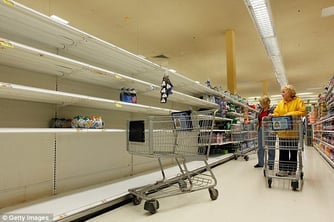 The merchandising rep walks down the aisle, slowly, carefully looking at each shelf, eyes darting up and down in a search for his company’s product. A look of worry forms on his face as he nears the end of the aisle. He double checks his documentation to make sure he is looking in the right place, turns around, and does another lap of the aisle--this time at a much quicker pace--hoping to find the product he needs.
The merchandising rep walks down the aisle, slowly, carefully looking at each shelf, eyes darting up and down in a search for his company’s product. A look of worry forms on his face as he nears the end of the aisle. He double checks his documentation to make sure he is looking in the right place, turns around, and does another lap of the aisle--this time at a much quicker pace--hoping to find the product he needs.
After 10 minutes of no luck, and some serious worrying, a store employee turns the corner into the aisle. “Can I help you find something?” After showing the employee the documentation, both employee and rep scour the shelves, but all for naught. Standing next to where the product should be located on the shelf, and sweating profusely, the field rep dials his manager’s number quickly and only hears the first ring before the store employee lets out a soft “Uh-Oh.” The field rep hangs up his phone, and looks to the pricing sticker that is on the ground, kicked indiscriminately beneath the shelving unit.
Checking his records the rep realizes that their last product was sold in this location nearly 3 weeks ago. To add to the rep's pain, a customer walks up and asks for help finding his company’s product. After hearing that it’s not currently available, she grabs a competing brand and heads to check out.
While this story may be a bit of hyperbole, retail out of stock instances, or OOS, are very real problems for many stock merchandising companies. In the world of CPG, consumers can be quick to find an alternative if their first choice isn’t readily available. This means lost sales, lost customers, and perhaps worst of all, a tarnished brand image. And out of stocks don’t just affect merchandisers. Prior to implementing a new system, Wal-Mart was reportedly missing out on nearly $3 billion a year because of retail out of stock instances. Even more telling for brands, merchandisers, and retailers is this study conducted by Thomas Gruen, Daniel Corsten, and Sundar Bharadwaj on consumer reaction to an OOS. According to the study, about 30% of consumers will actually go to another store to find their preferred product if the retailer does not have it in stock. That means almost 70% of out of stocks result in a lost sale.
So what is the solution to OOS? For merchandisers, an effective out of stock prevention strategy cannot rely on the retailer to be correct. Instead, merchandisers should have their reps in the field doing regular retail audits, using field activity management software. This way, reps can collect photo evidence that their product is or isn’t on the shelf and check price, promotion, and anything else that should be regularly monitored. While it may cost the organization a bit extra to have field representatives making these additional stops, if out of stock is a serious problem for the organization then the extra profit that comes in from always having product in stock should at the very least balance out costs.


 The merchandising rep walks down the aisle, slowly, carefully looking at each shelf, eyes darting up and down in a search for his company’s product.
The merchandising rep walks down the aisle, slowly, carefully looking at each shelf, eyes darting up and down in a search for his company’s product.

